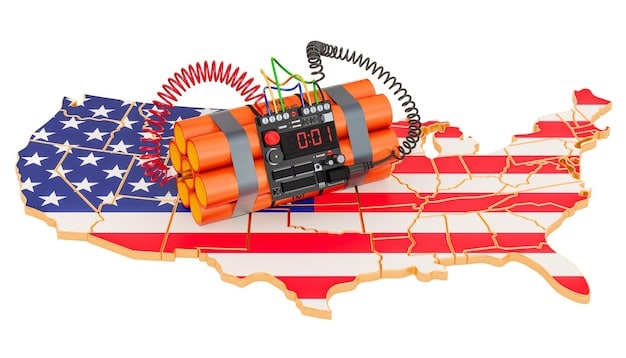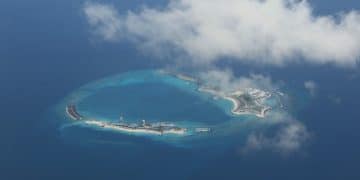US Withdrawal from Iran Nuclear Deal: Potential Consequences

The potential consequences of the US withdrawal from the Iran Nuclear Deal include increased nuclear proliferation risks, heightened regional tensions, economic instability in Iran, and a potential strain on international diplomatic relations.
The decision by the United States to withdraw from the Iran Nuclear Deal, formally known as the Joint Comprehensive Plan of Action (JCPOA), has triggered widespread debate and concern. Understanding what are the potential consequences of the US withdrawal from the Iran Nuclear Deal is crucial for assessing the stability of the Middle East and the future of nuclear non-proliferation efforts.
Understanding the Iran Nuclear Deal (JCPOA)
The Iran Nuclear Deal, officially the Joint Comprehensive Plan of Action (JCPOA), was a landmark agreement aimed at preventing Iran from developing nuclear weapons. It involved Iran and the P5+1 countries (China, France, Russia, the United Kingdom, and the United States, plus Germany), along with the European Union.
This section provides a concise overview of the deal’s origins, key provisions, and the motivations behind its creation. By understanding these elements, readers can better grasp the significance of the US withdrawal and its potential ramifications.
Origins and Objectives
The JCPOA emerged from years of diplomatic efforts to address international concerns about Iran’s nuclear program. The primary objective was to ensure that Iran’s nuclear activities remained exclusively peaceful.
Key Provisions of the JCPOA
Under the JCPOA, Iran agreed to significantly limit its uranium enrichment capabilities, reduce its stockpile of enriched uranium, and allow international inspectors from the International Atomic Energy Agency (IAEA) regular access to its nuclear facilities. In return, Iran received relief from various economic sanctions that had been imposed by the United States, the European Union, and the United Nations.
- Limitation of Uranium Enrichment: Iran was required to limit its uranium enrichment to 3.67%, which is far below the level needed for nuclear weapons.
- Reduction of Enriched Uranium Stockpile: Iran had to reduce its stockpile of enriched uranium to no more than 300 kg.
- IAEA Inspections: The IAEA was granted extensive monitoring and verification powers, including the right to conduct snap inspections of Iranian nuclear sites.
The JCPOA effectively placed Iran’s nuclear program under strict international supervision, making it difficult for the country to secretly pursue nuclear weapons development. The IAEA consistently reported that Iran was in compliance with the terms of the agreement prior to the US withdrawal.
The Iran Nuclear Deal represented a significant diplomatic achievement, offering a framework to prevent nuclear proliferation in a volatile region. However, the US decision to withdraw from the deal has undermined this framework, leading to a range of potential consequences that require careful consideration.
The US Withdrawal: Reasons and Justifications
In May 2018, the United States, under the Trump administration, officially withdrew from the JCPOA. This decision was based on several key arguments and justifications, which centered on perceived flaws in the agreement and broader US foreign policy objectives.
Examining these reasons provides essential background for understanding why the US took this controversial step and how it has shaped subsequent events. Understanding the justifications of the US withdrawal from the JCPOA is pivotal for analyzing its potential consequences.
Trump Administration’s Arguments
The Trump administration argued that the JCPOA was deeply flawed for several reasons. One primary concern was the sunset clauses, which meant that key restrictions on Iran’s nuclear program would eventually expire. Critics argued that these sunset clauses allowed Iran to resume its nuclear activities after a certain period.
Economic and Security Concerns
Beyond the nuclear aspects, the Trump administration also raised concerns about Iran’s behavior in the region. They argued that Iran was using the economic benefits it received from sanctions relief to support destabilizing activities in countries like Syria, Yemen, and Lebanon.
- Sunset Clauses: The expiration of key restrictions on Iran’s nuclear program was a major point of contention.
- Regional Activities: US officials claimed Iran was using sanctions relief to fund destabilizing actions in the Middle East.
- Enforcement: The US expressed doubts about the IAEA’s ability to effectively monitor Iranian compliance.
The US withdrawal was accompanied by the reimposition of stringent economic sanctions on Iran. These sanctions targeted Iran’s oil exports, financial sector, and other key industries, with the aim of compelling Iran to negotiate a new agreement that addressed US concerns.
The US withdrawal from the JCPOA and the subsequent reimposition of sanctions have had far-reaching effects, leading to a complex web of potential consequences that continue to unfold.

Increased Risk of Nuclear Proliferation
One of the most significant potential consequences of the US withdrawal from the Iran Nuclear Deal is the increased risk of nuclear proliferation. With the JCPOA no longer in full effect, Iran has gradually rolled back its commitments under the agreement, raising concerns about its nuclear ambitions.
This section assesses the potential for Iran to pursue nuclear weapons development and the implications for regional and global security. The US withdrawal from the JCPOA directly correlates with a higher risk of nuclear proliferation by Iran.
Iran’s Reduced Compliance
Since the US withdrawal, Iran has taken several steps to reduce its compliance with the JCPOA. These steps include increasing its stockpile of enriched uranium, enriching uranium to higher levels, and using advanced centrifuges.
Regional Security Implications
If Iran were to develop nuclear weapons, it could trigger a nuclear arms race in the Middle East. Countries like Saudi Arabia, Turkey, and Egypt might feel compelled to develop their own nuclear weapons to counter Iran’s nuclear capabilities.
- Uncertainty of Iran’s Intentions: The withdrawal has led to increased speculation about Iran’s ultimate goals regarding nuclear weapons.
- Regional Arms Race: Other countries in the Middle East could pursue their own nuclear programs in response to Iran.
- Weakened International Norms: The collapse of the JCPOA undermines the global non-proliferation regime.
The unraveling of the JCPOA has created a more dangerous and unpredictable security environment. The risk of nuclear proliferation not only threatens regional stability but also has broader implications for international peace and security.
The potential for nuclear proliferation underscores the urgency of finding a diplomatic resolution to the current crisis and restoring a framework for preventing Iran from acquiring nuclear weapons.
Heightened Regional Tensions and Conflicts
The US withdrawal from the Iran Nuclear Deal has contributed to heightened regional tensions and an increased risk of conflicts in the Middle East. With the JCPOA no longer serving as a check on Iran’s activities, the country has become more assertive in the region, leading to confrontations and proxy wars.
Examining these tensions provides insights into how the US withdrawal has affected the broader geopolitical landscape. Heightened regional tensions and conflicts are direct consequences of the US withdrawal from the Iran Nuclear Deal.
Proxy Wars and Regional Interference
Iran’s involvement in proxy wars in countries like Syria, Yemen, and Iraq has been a major source of regional instability. The US and its allies accuse Iran of supporting armed groups and militias that undermine the sovereignty and stability of these countries.
Attacks on Oil Tankers and Facilities
In recent years, there have been several attacks on oil tankers and energy facilities in the Persian Gulf region, which the US and its allies have blamed on Iran. These attacks have raised concerns about the security of global oil supplies and the potential for a wider conflict.
- Increased Assertiveness: Iran has become more assertive in its regional policies, leading to confrontations with its neighbors.
- Escalation of Conflicts: Existing conflicts in Syria, Yemen, and Iraq have been exacerbated by regional rivalries.
- Risk of Direct Confrontation: There is a growing risk of direct military confrontation between Iran and the US or its allies.
The US withdrawal from the JCPOA has not only failed to constrain Iran’s regional activities but may have emboldened it. The absence of a diplomatic framework has made it more difficult to de-escalate tensions and prevent conflicts.
Reducing regional tensions requires a comprehensive approach that addresses both the nuclear issue and the broader geopolitical dynamics in the Middle East. Diplomatic engagement and confidence-building measures are essential for preventing further escalation.
Economic Instability in Iran
The reimposition of economic sanctions by the United States has had a devastating impact on the Iranian economy. The US sanctions have targeted Iran’s oil exports, financial sector, and other key industries, leading to a sharp decline in economic growth and living standards.
Assessing the economic consequences of the US withdrawal provides insights into the internal pressures facing Iran and how these pressures may affect its behavior. Economic instability in Iran is a direct and significant consequence of the US withdrawal from the Iran Nuclear Deal.
Decline in Oil Exports
Iran’s oil exports have plummeted since the reimposition of US sanctions. The sanctions have made it difficult for Iran to sell its oil on international markets, depriving the country of a major source of revenue.
Impact on Living Standards
The economic crisis in Iran has led to increased unemployment, inflation, and poverty. Many Iranians are struggling to make ends meet, and there has been growing discontent with the government’s economic policies.
- Sharp Recession: Iran’s economy has experienced a sharp recession since the reimposition of US sanctions.
- Currency Depreciation: The Iranian currency has depreciated significantly, making imports more expensive.
- Social Unrest: Economic hardship has fueled social unrest and protests in Iran.
The economic instability in Iran has created a complex set of challenges for the government. While some argue that economic pressure could compel Iran to negotiate a new agreement, others fear that it could lead to further radicalization and instability.
Addressing the economic crisis in Iran requires a combination of sanctions relief and internal reforms. Finding a way to reintegrate Iran into the global economy could help stabilize the country and reduce regional tensions.

Strained International Diplomatic Relations
The US withdrawal from the Iran Nuclear Deal has strained diplomatic relations between the United States and its allies, as well as with other major powers like China and Russia. The US decision was met with criticism from many countries that had supported the JCPOA, leading to a divergence in foreign policy approaches.
Examining these strained relations is crucial for understanding the broader implications of the US withdrawal for international cooperation and multilateralism. The US withdrawal from the JCPOA has directly led to strained international diplomatic relations.
Divergence with European Allies
European countries like France, Germany, and the United Kingdom have remained committed to the JCPOA, despite the US withdrawal. They have attempted to salvage the agreement by finding ways to maintain trade and investment with Iran, but their efforts have been hampered by US sanctions.
Challenges to Multilateralism
The US withdrawal from the JCPOA has been seen by some as a broader challenge to multilateralism and the rules-based international order. The decision has raised questions about the reliability of US commitments and the future of international agreements.
- Transatlantic Divide: The US withdrawal has widened the transatlantic divide on foreign policy issues.
- Increased Mistrust: The decision has increased mistrust between the US and other major powers.
- Weakened International Cooperation: The collapse of the JCPOA has undermined efforts to address other global challenges.
Restoring international diplomatic relations requires a renewed commitment to multilateralism and diplomacy. Finding common ground on issues like nuclear non-proliferation and regional security is essential for rebuilding trust and cooperation.
The US withdrawal from the Iran Nuclear Deal has had a wide range of potential consequences, from increased nuclear proliferation risks to heightened regional tensions and strained international relations. Addressing these challenges requires a comprehensive and coordinated approach that combines diplomacy, economic incentives, and security measures.
| Key Point | Brief Description |
|---|---|
| ☢️ Nuclear Proliferation | Increased risk of Iran developing nuclear weapons. |
| ⚔️ Regional Tensions | Heightened conflicts and proxy wars in the Middle East. |
| 📉 Economic Instability | Severe economic decline in Iran due to sanctions. |
| 🤝 Diplomatic Strain | Strained relations between the US and its allies. |
FAQ
▼
The main goal was to prevent Iran from developing nuclear weapons by imposing strict limits on its uranium enrichment and allowing international inspections of its nuclear facilities.
▼
The US withdrew due to concerns about sunset clauses, Iran’s regional activities, and doubts about the effectiveness of inspections, seeking a more comprehensive agreement.
▼
Iran has reduced its compliance with the JCPOA by increasing its stockpile of enriched uranium, enriching uranium to higher levels, and using advanced centrifuges.
▼
The reimposition of US sanctions has caused a sharp decline in Iran’s oil exports, currency depreciation, increased unemployment, and overall economic instability.
▼
The move has strained relations between the US and its European allies, as well as with other major powers like China and Russia, leading to a divergence in foreign policy approaches.
Conclusion
In conclusion, the US withdrawal from the Iran Nuclear Deal has triggered a cascade of potential consequences, ranging from increased nuclear proliferation risks and heightened regional tensions to economic instability in Iran and strained international diplomatic relations. Addressing these challenges requires a comprehensive and coordinated approach that combines diplomacy, economic incentives, and security measures to ensure regional and global stability.





